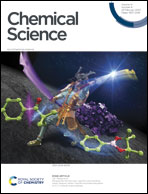A biocompatible and fully erodible conducting polymer enables implanted rechargeable Zn batteries†
Abstract
Implanted rechargeable batteries that can provide energy over a sufficient lifetime and ultimately degrade into non-toxic byproducts are highly desirable. However, their advancement is significantly impeded by the limited toolbox of electrode materials with a known biodegradation profile and high cycling stability. Here we report biocompatible, erodible poly(3,4-ethylenedioxythiophene) (PEDOT) grafted with hydrolyzable carboxylic acid pendants. This molecular arrangement combines the pseudocapacitive charge storage from the conjugated backbones and dissolution via hydrolyzable side chains. It demonstrates complete erosion under aqueous conditions in a pH-dependent manner with a predetermined lifetime. The compact rechargeable Zn battery with a gel electrolyte offers a specific capacity of 31.8 mA h g−1 (57% of theoretical capacity) and outstanding cycling stability (78% capacity retention over 4000 cycles at 0.5 A g−1). Subcutaneous implantation of this Zn battery into Sprague-Dawley (SD) rats demonstrates complete biodegradation in vivo and biocompatibility. This molecular engineering strategy presents a viable avenue for developing implantable conducting polymers with a predetermined degradation profile and high energy storage capability.



 Please wait while we load your content...
Please wait while we load your content...